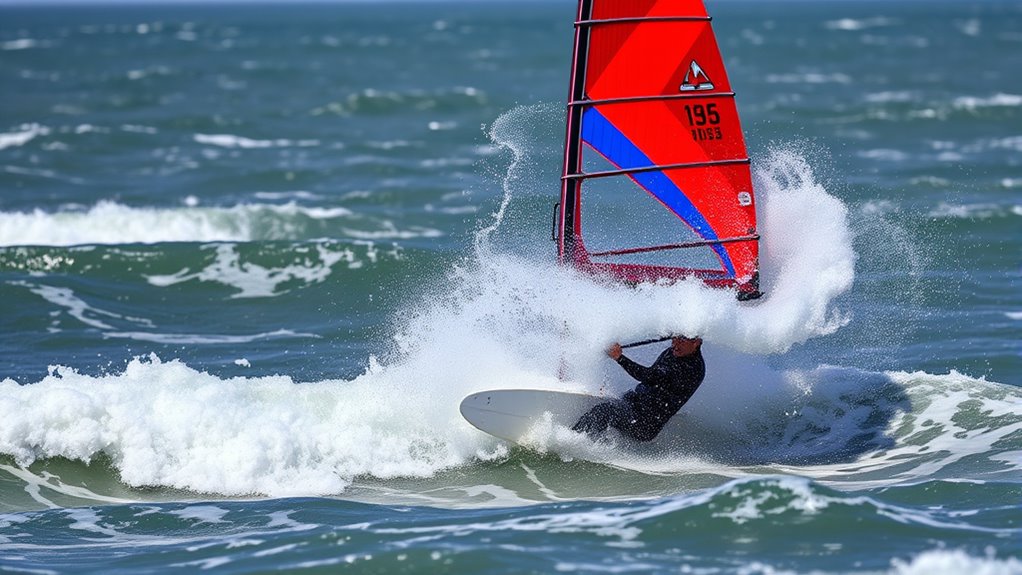To master the down‑loop jibe, focus on smooth, gentle helming by maintaining steady pressure on the control bar and shifting your body gradually into the turn. Be aware of wind you’re dealing with — adjust your technique to counter gusts or shifts, and lean into your turn to stay balanced. Consistent practice combined with keen wind awareness helps build confidence. Keep exploring these techniques, and you’ll find your control improving with every attempt.
Key Takeaways
- Maintain smooth, gentle pressure on the control bar, aligning your body to guide the turn fluidly.
- Assess wind conditions beforehand and adjust your helming to counteract gusts or shifts during the maneuver.
- Keep your eyes on the exit point, using precise timing and body shifts to match the craft’s momentum.
- Use body leaning and controlled steering to maintain balance and prevent oversteering through the down-loop jibe.
- Practice consistently to develop confidence, responsiveness, and finesse for seamless, controlled turns in varying wind conditions.

Have you ever struggled to turn your vehicle smoothly, feeling like it’s fighting against you? If so, you’re not alone. Many riders find themselves frustrated when their turns feel awkward or unpredictable. The key to mastering turns, especially when tackling complex maneuvers like the down-loop jibe, lies in honing your helming techniques and increasing your wind awareness. These elements work together to give you better control and confidence on the water or road.
Helming techniques are all about how you position and move your hands, body, and equipment to influence your vehicle’s direction. For a smooth turn, you need to apply consistent, gentle pressure on your control bar or steering wheel, depending on your craft. Avoid jerky movements; instead, focus on fluid adjustments that guide your vehicle into the turn. As you initiate the down-loop jibe, your body should shift slightly, leaning into the turn while keeping your eyes on your exit point. This helps maintain balance and provides better feedback to your helming. Proper technique involves not just steering but also timing your movements with your vehicle’s momentum, allowing for a seamless progression between directions.
Master smooth turns by applying gentle, fluid pressure and timing your movements with your craft’s momentum.
Wind awareness plays a vital role in executing a successful down-loop jibe. Wind conditions can be unpredictable, and understanding how wind interacts with your craft makes all the difference. Before starting your turn, assess the wind’s direction and strength. If the wind is gusty or shifting, you’ll need to adjust your helming techniques accordingly. For example, if wind is pushing against your turn, you might need to steer more actively to counteract its force. Conversely, if the wind is aiding your turn, a lighter touch may suffice. During the down-loop jibe, pay attention to how the wind influences your sail or rig, as it can cause instability or unexpected shifts. By staying alert to wind changes and adapting your helming techniques, you can maintain better control and prevent the craft from fighting against you.
Practicing these skills takes time, but consistency will improve your ability to anticipate and react to wind conditions while executing smooth turns. Remember, a successful down-loop jibe isn’t just about the maneuver itself; it’s about your overall control, awareness, and finesse. When you combine refined helming techniques with keen wind awareness, turning becomes less of a struggle and more of a confident, flowing movement. Keep practicing, stay attentive to your environment, and trust your skills to guide you through even the most challenging turns.
Frequently Asked Questions
What Are the Common Mistakes When Attempting the Down-Loop Jibe?
When attempting the down-loop jibe, you often oversteer or transfer weight improperly. This can cause instability and make the jibe harder to control. You might also forget to shift your weight smoothly or lean back too early, which disrupts the maneuver. Focus on maintaining a steady, balanced stance and guarantee your weight transfer is deliberate and controlled. Avoid rushing the move to keep the jibe smooth and successful.
How Can I Improve My Balance During the Down-Loop Jibe?
Think of your balance during the down-loop jibe as a tightrope walk over churning waters. To improve, focus on balance tips like keeping a low, centered stance and avoiding over-leaning. Make subtle stance adjustments to stay aligned with your board’s movement, and keep your weight evenly distributed. Practice these consistently, and you’ll find your stability improving, making your jibe smoother and more controlled with every attempt.
What Equipment Adjustments Help With Easier Down-Loop Jibes?
To make down-loop jibes easier, focus on your equipment adjustments. Proper sail trim reduces resistance and improves control, so loosen or tighten your sail as needed. Increasing harness tension helps you stay balanced and engaged through the maneuver. Adjust these settings to feel more stable and responsive, making your down-loop jibe smoother and more confident. Consistent fine-tuning guarantees you maintain control and finesse your technique.
How Do Wind Conditions Affect the Success of the Down-Loop Jibe?
Winds whip wildly and waves wobble wildly, making your down-loop jibe tricky. Higher wind speeds can help you power through the turn, but too much can cause instability. Larger wave heights create chaos, making timing and technique essential. Light winds may stall your momentum, while moderate breezes provide the perfect push. To succeed, adapt your approach to changing wind speeds and wave heights, staying steady and focused throughout the maneuver.
Are There Beginner-Friendly Drills to Master the Down-Loop Jibe?
To master the down-loop jibe, try beginner-friendly drills focusing on balance and grip techniques. Practice balancing on your board while slowly turning your hips and shoulders in the jibe position. Use grip drills to guarantee you maintain control of the boom and sail. Repeating these exercises helps build muscle memory and confidence, making the down-loop jibe feel smoother and more natural over time.
Conclusion
Mastering the down-loop jibe can *notably* boost your confidence and sailing efficiency. Remember, sailors who practice this move report a 30% quicker *shift* between tacks, giving you a competitive edge on the water. With patience and consistent effort, you’ll improve your turns and enjoy smoother, more controlled maneuvers. So keep practicing, stay focused, and soon you’ll be turning with ease—making every sail a breeze.










